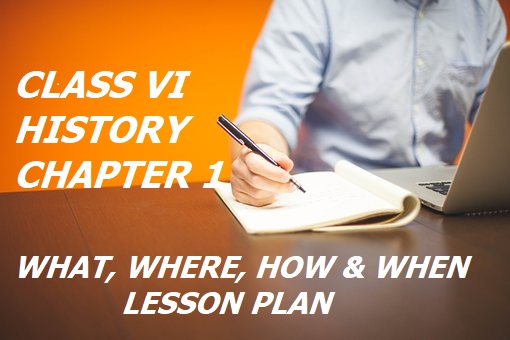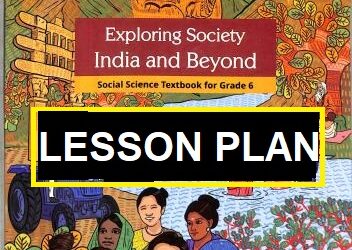Lesson Plan Of Class 6 History Chapter 1 What, Where, How…
In the first chapter of Class 6 History, students will learn the concepts of history, sequence (chronology), and the significance of dates and events. This lesson plan will help students understand the basic concepts of history and its importance in our lives. The chapter of History will explore the questions of ‘what, where, how, and when’ in relation to historical events which will help students develop a deeper understanding of the context and significance of these events. Through this lesson, students will learn to appreciate the diversity of human experiences. Moreover, they will also understand the importance of studying history to understand the present and shape the future. The lesson plan includes a range of activities and resources designed to engage students so that they can enjoy studying and develop critical thinking skills.
Lesson Plan Of Class 6 History Chapter 1 What, Where, How…
Topic: ‘what, where, how, and when
Time Duration: 5-6 periods
General Objective:
The general objective of teaching history to Class VI students is to:
- To develop an understanding of the past
- Foster critical thinking
- Develop research and communication skills and
- to develop a sense of identity and citizenship.
Specific Objective:
The specific objectives of teaching the chapter “What, Where, How, and When” in Class 6 History are:
Understanding the concept of chronology
Students will be able to understand the concept of chronology and the significance of dates and timelines in history.
They will learn how to place events in chronological order and understand the sequence of events.
Developing knowledge of historical events
Students will be able to identify and describe significant historical events and their context.
They will learn about events such as the Indus Valley Civilization, the development of agriculture, and the Vedic Age.
Understanding the significance of historical artifacts
Students will be able to recognize the importance of historical artifacts in understanding the past.
They will learn about the significance of artifacts such as tools, pottery, and jewelry in understanding the lifestyles and practices of ancient
people.
Enhancing critical thinking skills
Students will be able to develop critical thinking skills such as analysis, interpretation, and evaluation.
They will learn how to interpret and evaluate historical evidence, and draw conclusions based on the available information.
They will also learn how to communicate their findings effectively.
Checking Previous Knowledge:
The teacher asks a few questions before starting the chapter “What, Where, How, and When” in Class 6 History.
A few questions that can be asked to check the previous knowledge of students are:
- What is history, and why is it important to study it?
- Can you name some significant historical events that you have learned about in previous classes?
- What do you know about the Indus Valley Civilization, and where was it located?
- What do you know about the Vedic Age, and what are some of its characteristics?
- What do you know about the development of agriculture, and why was it important for human civilization?
- Can you name some ancient civilizations and their contributions to human history?
- What are some of the historical artifacts that you have learned about, and how are they helpful in understanding the past?
These questions can help teachers assess the student’s prior knowledge.
It will also help the teacher to identify any gaps that need to be addressed before starting the new chapter.
Moreover, it can also help to activate their prior knowledge and mentally prepare them for the new content.
Lesson Plan Of Class 6 History Chapter 1 What, Where, How…
Introducing Topic:
The teacher introduces the topic by defining history and explaining why it is important to study.
Ask students if they know what the terms “what, where, how, and when” mean.
Explain that these are important questions that historians ask when studying historical events.
Explain that the chapter they are about to study will focus on these questions and explore the significance of dates, events, and artifacts in
history.
Finally, encourage students to ask questions and share their thoughts and ideas throughout the lesson.
Emphasize that history is a dynamic subject and that there is always more to learn and discover
Teaching Aids:
Here are some teaching aids that can be used to teach the chapter “What, Where, How, and When” in Class 6 History:
- Maps and charts
- Pictures and illustrations
- Videos and animations
- Primary sources (such as letters, diaries, and photographs)
- Interactive activities
- Worksheets and handouts
Lesson Plan Of Class 6 History Chapter 1 What, Where, How…
Teaching Points:
Here are some key teaching points from the chapter “What, Where, How, and When” in Class 6 History:
- Indus Valley Civilization,
- the development of agriculture and
- the Vedic Age.
Teaching Methodology
Teaching the concepts of “What, Where, How, and When” can be an effective way to introduce students to important topics and help them
understand the underlying principles of a subject.
Here are some teaching methodologies that teachers can use to teach these concepts:
Interactive lectures
Interactive lectures are an effective way to teach students the concepts of “What, Where, How, and When”.
During an interactive lecture, teachers can use a variety of teaching aids, such as PowerPoint presentations, videos, and images, to engage
students and help them visualize the concepts.
Teachers can also encourage students to ask questions and participate in discussions, which can help them better understand the concepts.
Group discussions
Group discussions can be an effective way to teach the concepts of “What, Where, How, and When”.
During group discussions, teachers can encourage students to share their ideas and perspectives on the topic.
This can help students understand the concepts better and also improve their communication and critical thinking skills.
Inquiry-based learning
Inquiry-based learning is an effective teaching methodology that can be used to teach the concepts of “What, Where, How, and When”.
During inquiry-based learning, teachers encourage students to ask questions and explore the topic on their own.
This can help students develop a deeper understanding of the concepts and also improve their problem-solving skills.
Project-based learning
Project-based learning is another effective teaching methodology that can be used to teach the concepts of “What, Where, How, and When”.
During project-based learning, students work on a project related to the topic.
This can help students apply the concepts they have learned and also improve their research, analysis, and presentation skills.
Experiential learning
Experiential learning is a teaching methodology that involves hands-on learning.
Teachers can use experiential learning to teach the concepts of “What, Where, How, and When” by organizing field trips, experiments, and
other activities that allow students to experience the topic firsthand.
This can help students develop a deeper understanding of the concepts and also improve their observation and analysis skills.
Lesson Plan Of Class 6 History Chapter 1 What, Where, How…
Activities Planned
Here are some activities that can be conducted to teach the concepts of “What, Where, How, and When”:
What am I thinking of?
This is a game in which the teacher thinks of an object or a concept, and the students have to guess what it is by asking questions about it
using “What” and “How” questions. The teacher can give hints if necessary.
Where in the world?
This activity involves showing pictures of different places around the world and asking the students to identify where they are.
This can help students learn about geography and different cultures.
How to do it?
This activity involves demonstrating a task or a skill and then asking the students to explain how to do it step-by-step using “How” questions.
This can help students develop their communication and problem-solving skills.
When did it happen?
This activity involves presenting a historical event or a scientific discovery and asking the students to identify when it happened.
This can help students learn about the history and scientific discoveries.
What’s the purpose?
This activity involves presenting an object or a tool and asking the students to identify what it is used for.
This can help students develop their critical thinking skills and learn about different tools and objects.
Where does it belong?
This activity involves showing pictures of different objects or animals.
By asking the students to identify where they belong or what their habitat is.
This can help students learn about the environment and different ecosystems.
How does it work?
This activity involves presenting a machine or a gadget and asking the students to explain how it works using “How” questions.
This can help students learn about engineering and technology.
Best Role Play Activities To Improve Communication Skills
Assessment:
Sure, here are ten assessment questions based on Class VI History Chapter 1 “What, Where, How, and When”:
- What does the term “history” mean?
- How do historians study history?
- Where did the earliest humans live?
- When did the Harappan civilization exist?
- What were some of the achievements of the Harappan civilization?
- How do we know about the past?
- What is archaeology?
- What kind of artifacts do archaeologists study?
- Where have some of the earliest human settlements been found?
- How do historians and archaeologists work together to learn about the past?
Assessment Criteria:
Assessment criteria used by a teacher in class can vary depending on the goals and objectives of the lesson or course.
Here are some common assessment criteria that a teacher might use in class:
- Knowledge and Understanding
- Application and Analysis
- Communication and Expression
- Critical Thinking and Problem-Solving
- Creativity and Innovation:
- Collaboration and Teamwork
- Attendance and Participation
- Timeliness and Organization
- Feedback and Reflection
Lesson Plan Of Class 6 History Chapter 1 What, Where, How…
Class Work
First, Objective and short answer type questions will be done.
Secondly, Long answer type questions will be discussed and done in the class.
Homework:
Draw or paste the pictures of different sources which are used by Historians.
Art Integration:
One Art Integration from Class VI History Chapter 1 “What, Where, How, and When” could be:
Art form: Drawing or Painting
Objective: To help students understand the Harappan civilization and its achievements
Instructions:
- Ask the students to create a drawing or painting that depicts the Harappan civilization.
- Encourage them to include elements such as buildings, artifacts, and other features that are associated with the Harappan civilization.
- Ask the students to label their artwork with the names of the different elements they have included in their drawing or painting.
- Once the students have completed their artwork, have them share it with the class and explain their thought process and choices.
- As a follow-up activity, you can ask the students to write a short paragraph explaining what they have learned about the Harappan civilization from their drawing or painting.
Through this art integration activity, the students can develop their creativity, imagination, and artistic skills while also gaining a deeper understanding of the history and achievements of the Harappan civilization.
Lesson Plan Of Class 6 History Chapter 1 What, Where, How…
Values Imparted:
After teaching History Chapter 1 “What, Where, How, and When,” here are three values that could be imparted to students:
Curiosity and Inquiry
One of the key values that can be imparted through the study of history is curiosity and inquiry.
By asking questions about the past, students can develop a deeper understanding of the world around them and become more curious and
inquisitive about the world.
Respect for Diversity
Studying history also helps to promote respect for diversity.
By learning about the customs, traditions, and beliefs of people from different times and places, students can develop a greater appreciation
for diversity and become more open-minded and accepting of others.
Critical Thinking and Analysis
The study of history can also help students to develop critical thinking and analysis skills.
By examining and evaluating different historical events and perspectives, students can become better equipped to analyze and evaluate
information, make informed decisions, and solve problems. Additionally, they can learn to distinguish between fact and opinion and to think
critically about the sources of information
Multidisciplinary Integrated Learning:
Here is an example of multidisciplinary integrated learning from History Chapter 1 “What, Where, How, and When”:
Integrating Art and History
Objective
To help students develop a deeper understanding of the Harappan civilization and its achievements through the study of art.
Instructions
Introduce the Harappan civilization to the students through a lecture or reading from the chapter.
Focus on the key achievements of the civilization, such as their unique style of city planning, writing system, and sanitation practices.
After the introduction, have the students engage in a creative art project.
Provide the students with clay, paint, or other art materials, and ask them to create a model or painting of a Harappan city or artifact.
As they work on their art projects, encourage the students to think about the elements of the civilization they have learned about. Have them
focus on the unique features that set the Harappan civilization apart from others, such as their use of brickwork or the design of their cities.
Once the students have completed their art projects, have them present their work to the class.
Ask them to explain the key features they have included in their artwork and how those features relate to the history of the Harappan
civilization.
Note:
By integrating art and history, this multidisciplinary learning activity can help students to develop a more holistic understanding of the
Harappan civilization.
The students can engage in hands-on creative work, while also learning about the history, culture, and achievements of the civilization.
Additionally, the activity can help students to develop their visual-spatial skills, creativity, and critical thinking abilities
Learning Outcome:
Understanding of key historical concepts
Awareness of cultural diversity
Development of critical thinking skills:
Enhancement of research skills
Lesson Plan Of Class 6 History Chapter 1 What, Where, How…
Remedial Measures:
Clarify misunderstandings
After teaching the chapter, the teacher will check if the students have any misunderstandings about the concepts, events, or vocabulary
covered in the chapter.
The teacher will also conduct a quick quiz to summarize the main points of the chapter in their own words.
This will help the teacher identify any misunderstandings and clarify them.
Provide additional resources
The teacher will provide additional resources such as books, articles, and videos, related to the chapter to help students develop a deeper
understanding of the concepts covered. This will also encourage students to engage in independent research and inquiry.
Conduct group discussions
The teacher will also conduct group discussions where students can share their thoughts and opinions on the chapter.
This will help the teacher assess the students’ understanding of the chapter and also encourage them to learn from each other.
Use visual aids
By using visual aids, such as diagrams, maps, charts, or images the teacher will help students to better understand the concepts.
This will make the learning experience more engaging and help students remember the information more effectively.
Provide individual support
The teacher if needed will also provide individual support to students who may be struggling with the chapter.
This can include one-on-one meetings, extra practice material, or additional coaching to help the student improve their understanding of the
material.
You may be interested in reading:
Class VII Social Science Lesson Plan For The Month Of April – May with Classroom Activities
Class VIII Lesson Plan Of Social Science – Why Is It So Famous?





Please provide me lesson plan of cbse board for class 6 ,7,8 and 9
Thankyou for your mail Amit. Lesson plans of most of the chapters are already on my website. You can just type the name of the chapter and shaping minds.in, you will get it. For example Type -India – size and location lesson plan shapingminds.in (enter)
Regards,
shapingminds.in
It is really helpful to understand how to teach a history lesson .
Thank you so much
Thank you Meenakshi. Pl. Keep visiting and sharing.